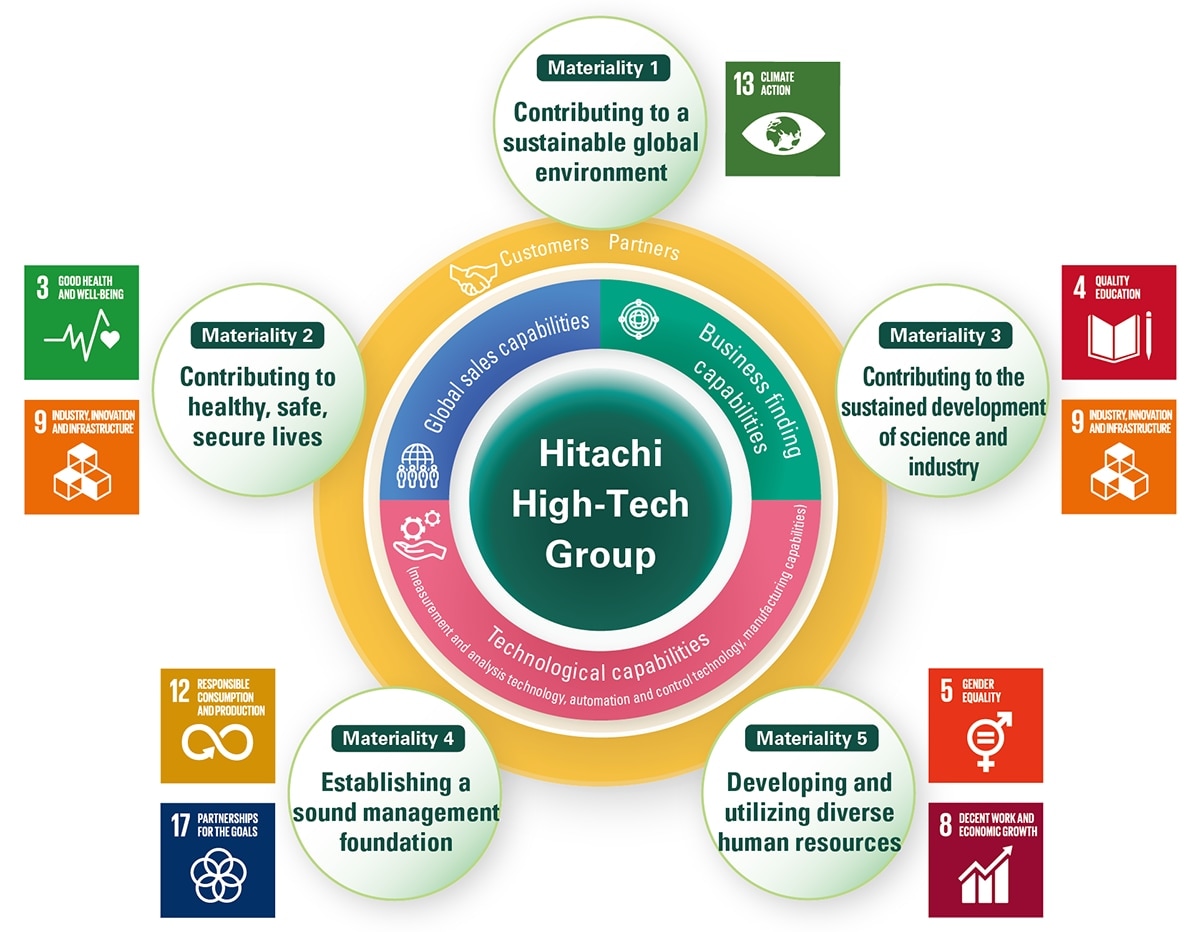
Sustainability

The transition to a carbon neutral economy is a pressing issue in the work to achieve a sustainable society. As a field, chemistry will play a significant role toward that end, notably in the development of more environmentally friendly materials.
Hitachi High-Tech Solutions Chemicals Informatics is a search service that uses AI to find necessary compounds for materials development. Using a database with over 100 million entries, it enables users to perform comprehensive searches by supporting them in finding a compound that suits their application.
AI handles a part of the work that used to be heavily dependent on experienced chemists in order to enable major reductions in R&D time, labor and costs. The service will play a role in providing society with new materials as swiftly as possible.
Conventional material development involves a repeated cycle of first formulating a hypothesis, selecting a material, then simulating, synthesizing and evaluating until a suitable compound could be found. It is fully dependent on seasoned technicians, experience, intuition and chance.
Chemicals Informatics, on the other hand, replaces the experienced chemist the process used to depend on with AI for a search and selection process. While this long and effort-intensive process used to have only a 1 in 100,000 chance of finding a useful compound, the probability rises to 1 in 100 when using AI*.

The AI technology of Hitachi High-Tech Solutions was first put to use in the healthcare sector. Services launched in 2019 with the physical therapy AI "awina."
The AI collected data from electronic medical charts from a 10-year span from a busy physical therapy hospital (around 18,000 entries). The service improved physical therapy quality at healthcare providers that adopted it by substituting AI for an experienced physician's findings based on that data.
"As a technology, AI can find effective approaches and make future predictions based on massive amounts of data and knowledge accumulated over time. This all began from by taking the mechanism confirmed as being effective in the healthcare sector and applying it to the chemistry sector,"
says Rei Kurokawa, Business Planning Division General Manager's Representative from the ICT Business Group, on the development of Chemicals Informatics.
Engineers were sent to perform development in US — an advanced AI hub — where they were able to catch up on the latest technology as they worked. The AI gained its specialist knowledge in the compounds involved by learning from researchers with years of material development experience at chemical manufacturers.
Looking back, Kurokawa says, "I mostly interacted with the researchers remotely, but we still communicated 'face-to-face,' enabling me to learn a lot."
Furthermore, the team spoke with more than 20 chemical manufacturers to ensure the system would be useful for a wide range of businesses before launching the "Chemicals Informatics" service in November 2020 with the help of other Hitachi Group divisions.

Just enter the target performance for the desired compound into Chemicals Informatics and click the search button. The AI will then find candidate compounds in the database.
"The database includes 117 million compounds and is comprehensive for all confirmed, existing compounds, both domestically and internationally. Being so comprehensive is one of its distinguishing factors." (Kurokawa)
No matter how amazing the chemist, it would be a challenge to fully assess all of more than 100 million compounds. Chemicals Informatics reliably finds properties that suit your goals, without overlooking significant compounds.
Furthermore, the database links to 30 million patents and papers, letting you check whether someone else has patented the compound you looked up. This avoids the risk of discovering infringement of rights after development has made headway, allowing you to move to practical development more rapidly through use of strategic R&D that targets unpatented sectors.
The AI uses natural language processing (NLP) to read compound properties, patents, and papers. NLP allows computers to process the languages humans speak, and excels at processing massive text files like research papers.
Chemicals Informatics also allows users to search through unknown compounds not included in the 117 million known compounds. The AI makes random changes to the structures of known compounds, generating new compounds and adding them to the database. The number of compounds discovered in this way has already risen to 11 million.
All compounds similar to a target compound can also be found in a comprehensive fashion.
"This feature is like the AI reproducing a experienced chemist's thinking. It is said that experienced chemists can take a look at a compound and imagine similar compounds and their likely properties, and are able to output that idea. Envision this as an AI doing the same thing." (Kurokawa)


Chemicals Informatics has seen use in development of additives for use in biodegradable plastics.
Typical plastics do not break down over extended periods, meaning plastic waste like grocery store bags has become a serious form of environmental pollution. In particular, minuscule microplastics are accumulating in fish and sea birds, ultimately having a negative impact on the entire ecosystem, including humans.
Hopes are high for biodegradable plastics as a solution to plastic pollution issues, as they are able to break down harmlessly and return to nature with no impact on soil or water. This field is drawing attention for major growth potential as a key part of a sustainable circular economy.
During development, the team needed to find an additive that accelerated breakdown as much as possible in order to reduce environmental impact, while also ensuring conventional plastic performance in terms of durability, flexibility, and moisture resistance.
Toward that end, they searched for a combination of polylactic acid (which is commonly used in biodegradable plastics), metal hydroxide additives, metal oxides and organics, and narrowed the search down to three optimal additive candidates.
"Where there used to be a limit on candidate compounds for consideration, we have expanded that from 600 to 60,000. At the same time, we reduced the time required for compound selection and simulation from 120 days to two days, and reduced numbers of prototyping, measurement, and evaluation cycles by four fifths. Customers have told us how pleased they are to have all of these time issue bottlenecks resolved in a single stroke." (Kurokawa)
Chemicals Informatics has also proven to be useful when searching for lithium-ion battery solvents. Lithium-ion batteries are used in electrical vehicles (EVs), home appliances, IT equipment, and a wide range of other products, accelerating a need to find solvents with higher conductivity for even more extensive use.
Conductivity refers to the ease with which electricity flows. Conductivity is an important factor in improving product performance, with higher conductivity increasing the range of EVs and the battery life of smartphones.
This is a comprehensive search for the oxide used by several dozen battery manufacturers. It produced 90 candidate combinations from out of around 10 million combinations of surrounding compounds and 1031 designated compounds.
"With the world using EVs, lithium-ion batteries have become a vital device for carbon neutrality, and we expect that development competition will continue to heat up from here. We could cite customers in a wide range of industries on that point already; not just battery manufacturers, but also those upstream and downstream in the supply chain,"
says Yoshihiro Okada, General Manager, IT Platform Div., ICT Business Group. With the need for Chemicals Informatics set to increase going forward, the team also has a sense of the challenge they face.
Okada went on, saying:
"Since the need for environmentally friendly material development is certain to increase, I want to help out a variety of customers, regardless of their industry. As a country with an aging population, Japan is guaranteed to experience a decline in its productive population. However, despite this decline, it should be possible for Japan to supplement its competitive edge with AI."
"It is absolutely vital to address the environment right now. I hope the system sees more use than ever for material development, and sparks innovations for decarbonization and a circular economy," Kurokawa says, thinking of the future.
Hitachi High-Tech Group has formulated five themes of materialities for social issues that must be addressed in light of sustainable development goals (SDGs).
"Chemicals Informatics" is deeply related to 1), 2), and 3) in particular. Development of new materials will be vital to the achievement of a carbon-free, recycling-oriented society, as well as food and water security for health, and the development of science and industry.
Hopes can only rise for "Chemicals Informatics" being used as a means of resolving social issues and achieving a sustainable society.
